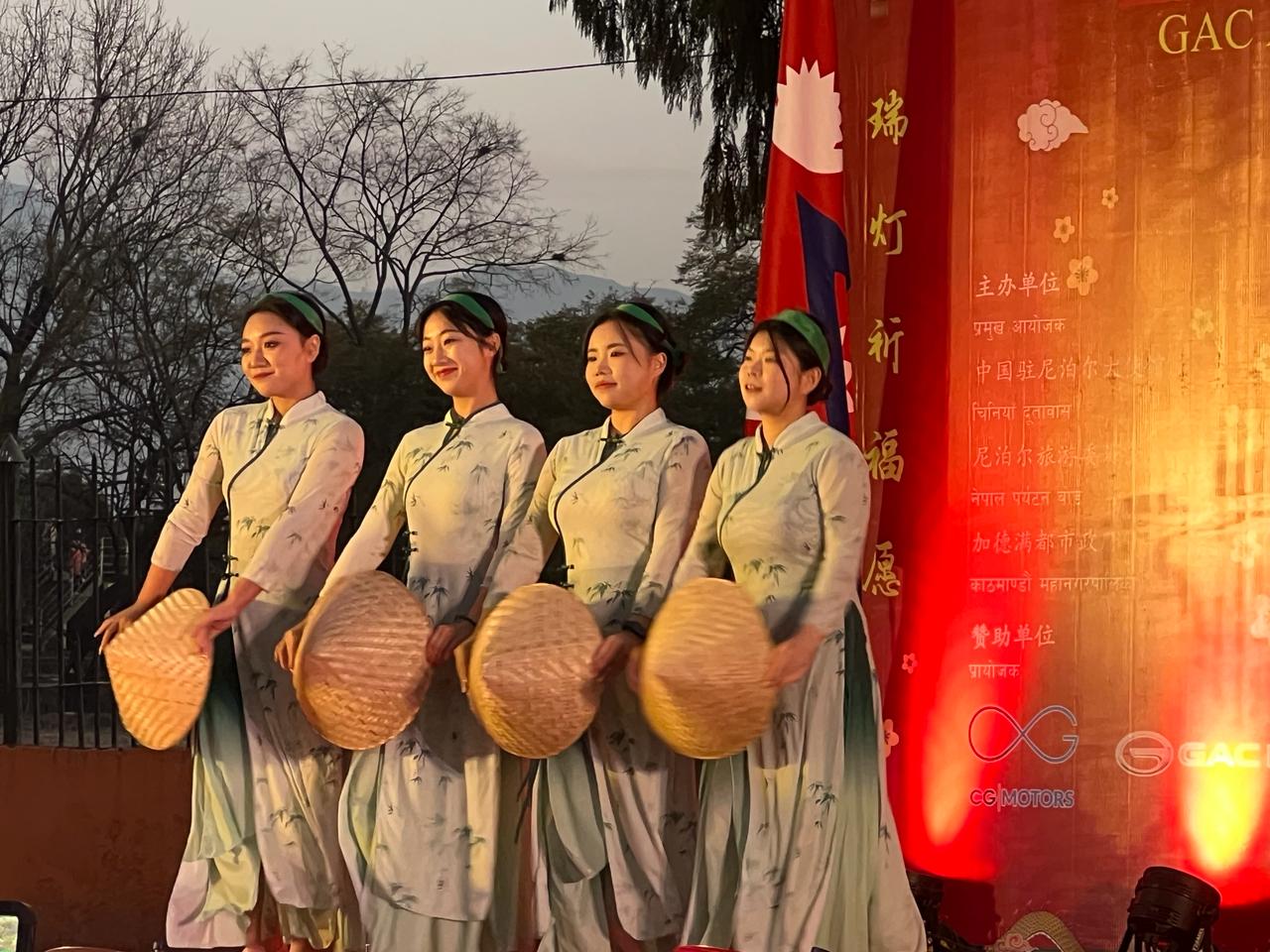
Beijing, Feb 8: After the COVID- 19 took a toll on all of us people were slowly forgetting to celebrate their festivals and embrace their culture but recovery can be observed as 1.4 billion Chinese were seen celebrating the new year with much fanfare.
Dragon toys, cartoon dragon pictures, sticker dragons, Mukunda dragons, claw dragons, dragon hats are all a way that people have found to embrace their culture as it incredibly crucial.
Not only that, but people are also subjecting their culture on foods as dragon pictures on various food items such as cakes and dragon decorations on various beverage containers were also perceived indicating to us how the chinese have such deep rooted connection with food.
The Chinese are welcoming the dragon year and bidding farewell the rabbit year in hopes for wealth, love and happiness in the upcoming year.
In traditional Chinese astrology, there is a cycle of 12 years. Each of these 12 years is symbolic to a different animal. In Nepal, various ethnic groups such as Sherpa, Tamang, Magar, Thakali, Bhutia, Gurung, etc., also count the year based on the names of 12 animals similar to the Chinese.
However, Nepalis refer to the Dragon year as the Garuda year instead.In the twelve-year cycle of Chinese astrology,the dragon is just a mythical creature but the other 11 animals can be seen and touched physically.
Even though the dragon is an imaginary animal, in the languages of Nepali Tamang and Sherpas, it is called “Dukpa”. This term has been present in Nepali society for thousands of years, despite the dragon’s mythical nature.

Chinese have their own way , a unique tradition of celebrating the New Year. For instance, those born in the year of the Dragon must wear red-coloured innerwear from the coming Saturday.
As per these circumstance many chinese women are seen with red scarves and red bracelets . Likewise, the men are also participating in this custom as men are also seen wearing red vests and bracelets during the festival. During this festive occasion, Chinese people give money in red envelopes to younger relatives, a culture known as “Hongbao.” In today’s digital age, as they are sending their distant young ones hongbao through online banking.
During the Chinese Spring Festival, various fairs, festivals, processions, and displays are held in different places. At this time, Nepalis decorate their homes, streets, markets, and offices with dragon dances, lion dances, traditional Nepali dances, and colorful lights, much like during their own festival of Dashain.
Every Chinese surely has some fascinating tale to share about this spring festival. This article composes facts about the trips the Chinese take during the Spring Festival and the tales that come with it. While many live under the assumption that during the Spring Festival, Chinese engage in extensive travels.

The embarkment Chinese take during the Spring Festival is one of the largest human migrations in the world. the duration of the Chinese Spring Festival travel is estimated to last from January 26th to March 5th, approximately 40 days. This is also known “Chunyun” in Chinese, which translates to Spring Festival travel.
According to estimates of China’s Ministry of Transportation and the Spring Festival travel rush, the number of tourists traveling within China during the current year’s Spring Festival period is expected to reach 9 billion. China has a total population of 1.4 billion. Based on this calculation, during the Spring Festival travel period, every Chinese citizen will embark on more than 6 trips. This is double the number compared to the year 2023.
The main days of the Spring Festival, from February 9th to 15th, will see the sale of rail tickets within the period reaching 1500 per second.

During this period of time, all railways in China are expected to accommodate 480 million passengers. An average of 120 million passengers will travel by train daily.
This estimated number represents an increase of 37.9% compared to 2023. On the first day of Chunyun, which lies on January 26th, the national railway network in China provided travel services to 16 million passengers in a single day.
Likewise on February 2nd, which corresponds to January 19th in the lunar calendar, the eighth day of Chunyun was observed. On that day, it was publicly announced that during this period, 1.35 billion Chinese had participated in travel within the first week alone.
The Spring Festival holiday officially begins on February 10th, Saturday, and lasts only one hour for public holidays until February 27th, Saturday.
According to Reuters, the bustling scenes during the Spring Festival travel season in China not only showcase the rapid growth of passenger flow but also indicate China’s economic recovery and the presence of vitality. During this period, Chinese retail sales are expected to reach 5 trillion yuan, providing a significant boost to China’s economic development.
Despite the COVID pandemic, there has been a visible increase in travellers in China during the open Spring Festival season. After witnessing the COVID pandemic in China during the Spring Festival of 2021, Chinese netizens had posted messages on social media saying, “Let’s stay at home this time and celebrate Spring next year.”
However, the same situation was repeated in the following year, 2022. Three consecutive Spring Festivals of staying at home has made chinese people excited and roused to celebrate in a mass with others with just as enthusiasm as them.

Travelling and family reunions during the Spring Festival lead to lavish feasts, making Spring Festival a costly affair for the Chinese.During this period of time a significant amount of money is spent on various lavish items causing the market to skyrocket remarkably. It is said that about a third of the annual expenses for Chinese people occurs during the Spring Festival.
During the Spring Festival, the Chinese prioritize foreign travel as well, with significant cultural partners such as Singapore, Thailand, South Korea, and Japan being the preferred destinations.
However, Nepal is not particularly highlighted as a destination for Chinese travelers due to insufficient infrastructure for Chinese tourists and the lack of additional facilities while developed countries such as Singapore and Thailand announce various facilities for Chinese tourists during the Spring Festival welcoming them with open arms.

Chinese Spring Festival is often depicted as a non-material cultural heritage. Since this year, the United Nations has included the Chinese Spring Festival in its calendar, giving it more international recognition.
On February 6th, Wednesday, a press conference was held in Beijing as part of the Chinese Foreign Ministry’s regular press conference. Foreign Ministry spokesperson Wang Wenbin revealed that more people worldwide are now celebrating the Chinese Spring Festival, categorising it as a fashion trend.
He said that this year, the Chinese New Year has been officially recognized by the United Nations General Assembly as United Nations Day, marking the first formal entry of the traditional Chinese festival into international rituals.
Nearly 20 countries around the world now publicly celebrate Spring Festival, and about 20% of the world’s population also celebrates Spring Festival in various ways.

As the Chinese Spring Festival approaches, markets for Spring Festival-related goods are also booming in various regions worldwide.
According to data from Alibaba Group’s cross-border e-commerce platform, spring-related items such as lucky red lanterns are popular in more than 100 countries worldwide allowing Chinese culture to be flaunted worldwide.
Consumers consider the quality of “Made in China” goods to have excellence. Previously, Chinese goods were often criticized with the slogan “Made in China yesterday, none today,” but now China is producing high-quality and expensive products, gaining confidence and value in the international market.
Moreover, Alibaba has been a very helpful platform that conveys the role of convenient and trustworthy position in the e-commerce platform.

The special cultural and custom significance of Chinese goods has also increased their importance and value in the international market.
Intangible cultural heritage, such as Chinese paintings, traditional Chinese costumes, and Chinese tea, is popular overseas which have skyrocketed in market value. China’s rockery exhibition, the Ji 20 Summit, and the Dabao exhibition provide international platforms. The 5,000-year history of Chinese civilization has provided a solid cultural foundation for “Made in China” goods, showing different but shared concepts of beauty,harmony and peace.
-With the help of Ashwini Aryal
















